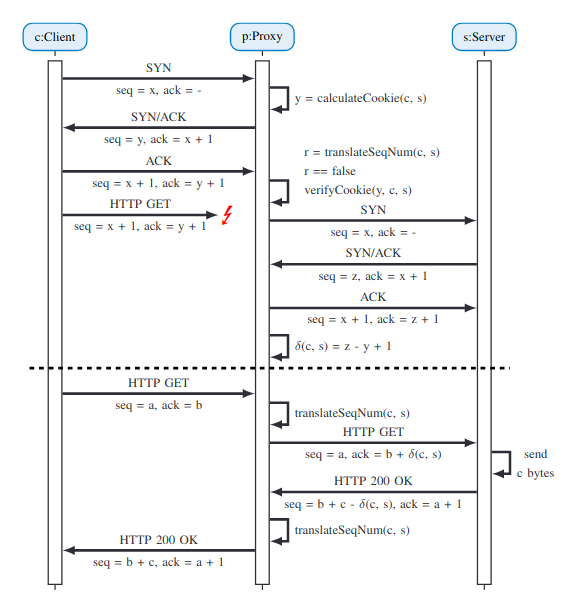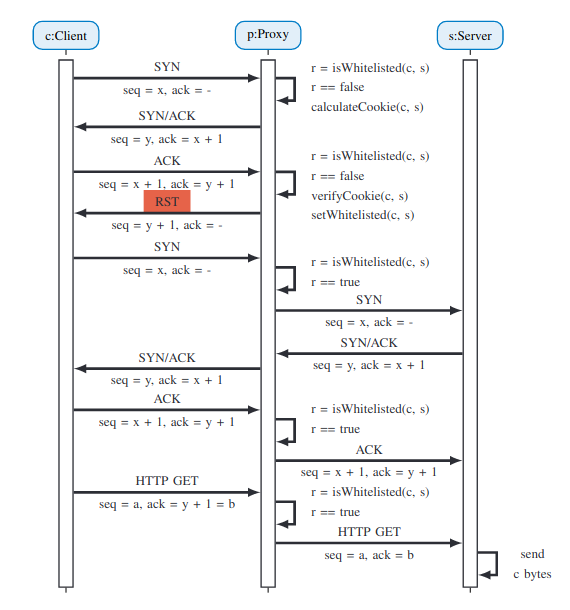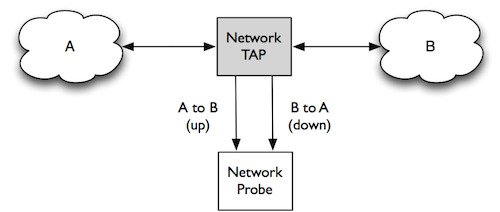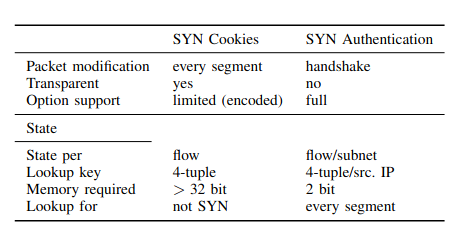Header contains
- Source and destination addresses.
- SYN (synchronize) and ACK (acknowledge) flags.
- Other valuable information (see figure below).
- Client sends SYN.
- Server receives and responds with SYN ACK.
- Client receives and responds with ACK.
This process is the 3-way handshake to establish a Client-Server connection [Fox, 2019].
- Malicious client sends 1 part of 3-way handshake, SYN segment.
- The server notices this flow, allocates resources for the connection
- The server acknowledges by sending a TCP SYN ACK segment and continues waiting for the client's response.
- The client continues sending these TCP/IP segments to establish various TCP connections.
- Indefinitely, the server can run out of resources allocated to these connections - resulting in deadlock, and possible valid TCP connections being dropped. [Scholz, 2020]
- Increased Server backlog
- Scaling the capacity of TCP stack storage.
- Reduced SYN timer
- Decrease the time allowed between sending SYN-ACK and waiting to receive ACK.
- Overwriting half-opened TCP Stack entries
- Replace oldest half-opened connection with incoming SYN segment.
These methods are proven to be ineffective [rfc4987, 2007] since the attacker could easily linearly scale the frequency of SYN-segments sent.
- SYN-cookies
- Uses a hidden cryptographic hash function to compete and store a secrete key.
- Function of the timestamp and source- and destination address of the received SYN-segment.
- Only adds an entry to the TCP stack once the final ACK is received and corresponds with the hash value stored.
- Finally opens connection between client and server. [A10 Networks, 2019]
- Firewall & Proxy Filtering
- Ensures that only legitimate connections are established with the end user/server.
- By handling the 3-way handshake on the firewall side and passing the connection via proxy to server [rfc4987, 2007].
Programmable data planes (PDP) enables network operators with a tool to change/modify the purpose of a network switch.
The acronym PPPP stands for Programming Protocol-Independent Packet Processors. P4 is a programming language for controlling packet forwarding planes in network devices. It is open source and maintained by the P4 Language Consortium (https://p4.org/).
- Check and modify packet headers s.t custom requirements [Gao, 2021].
- Encapsulate and forward packets with a non-IP protocol defined via an IP network [Jacobs, 2019].
- Utilize hardware speeds (100 Gb/s) to perform tasks.
- Load balancing, comms with other devices via controller [Geo, 2021].
- More Cost-effective (time and monetary) than purpose specific chips.
- Adaptable for new application scenarios.
- Apply resources according to case requirements.
- Although PDP is capable of doing competitions it's at the expense of throughput.
- PDP's only supports simple arithmetic operations thus precalculations and/or approximations need to be loaded in a match-table or registers.
- Lacks correctness verification - developers writing code for forwarding behavior on the data plane of a pdp is not as knowledgeable as the equipment manufacturer.
- Traffic Measurement and -Engineering
- Congestion detection
- Active queue management
- Load balancing
- Routing and Forwarding
- L4 load balancing
- Source routing
- Named data networking
- Advanced Network Support
- 5G networks
- IoT
- Time-sensitive networks
- Network Security
- Intrusion detection
- Encryption
- DDos attack mitigation [project focus]
- Topology scrammingling
- Network Accelerated Computing
- Machine learning
- Assist Deep packet inspection
[Geo, 2021]
The concept of a SYN-Proxy is based on the idea of intercepting potentially harmful traffic before it reaches the server. In addition, installing a dedicated SYN-Proxy allows the server to save resources by not handling attack mitigations itself.
According to [Scholz, 2020] only the following strategies provide adequate protection and high service quality:
- SYN-Cookie.
- SYN-Auth with cryptographic hash.
- SYN-Auth without cryptographic hash.
- Secured with a cryptographic hash bound to the flow.
- expects an appropriate final segment of TCP handshake.
- On Completion connection is forwarded to the application.
Fig. above shows SYN-Cookie message exchange strategy.
- Whitelists the client or client's subnet on completion.
- Accepts future connections from source or subnet.
- Can be combined with a cryptographic hash.
Fig. above shows the simplicity of SYN-Authentication message exchange strategy.
In the study [Scholz, 2020], the stack used to find if it is possible to mitigate SYN-attacks with a programmable data plane is described below.
Libmoonfor SYN proxy prototype in software targeting Commercial Off The Shelf hardware.- Powerful and easy-to-use scripting on top of DPDK's packet handling.
- Proxy runs as userspace program.
- TCP handshake done by proxy application.
- Libmoon receives and processes packets in batches.
- Hash function
- Peudo-cryptographic
SipHashfunction for cookies and hashmap SipHashcan be integrated with programmable software and hardware dataplanes. Found here.
- Peudo-cryptographic
- Connection State Tracking
- Garbage collection with second chance page replacement algorithm.
- Each state extends two bits. If neither are in a set state, entry is inactive and removed.
- SYN-Authentication
- Fixed size
bitmapas Data Structure (DS) for whitelist. - ForEach, two bits used for second-chance page replacement algorithm for total of 1GB for entire IPv4 address space.
- IPv6 whitelisting based on subnet or hash-based DS.
- Fixed size
- SYN-Cookies
- Two hash maps (
activeandhistory) in conjunction historyreplace is periodically deleted and replace by anactivemap, and new empty active hash map is initialized.- 2-phase lookup - First
activemap is checked. - If entry exists it is returned.
- Else same lookup is done in
historymap and entry is copied toactiveand employs the second chance mechanism. - Else if no entry is found the connection is assumed to not exist.
- Inserts are exclusive to
activemap.
- Two hash maps (
- Optimizations
- Offloading feature of NIC used for checksum calculation.
- ForEach TCP packet received only one action is performed resulting in one outgoing packet.
P4 enables rapid development cycles and creates portable implementations of network applications for ASIC, FPGA and SmartNIC data planes.
- Realized Programs and Targets
- SYN cookie and SYN authentication strategies implemented with P4 program
- Test functionality using Mininet-based bmv2 P4 target switch.
- Small modifications to P4 programs due to using different P4 architecture models.
- Used Targets t4p4s since it uses the same underlying framework as libmoon implementation.
- Ported implementation to FPGA based data plane - Agilio Network Flow Processor (NFP)-4000 SmartNIC and NetFPGA SUME
- Program Core
- Packets are parsed up to and incl. TCP header.
- MAC addresses are updated using a lookup table.
- Packets are modified to strategy used, TCP flags set and state stored by proxy.
- State is maintained as a match-action table, requiring one lookup for each segment.
- IP addresses are swapped.
- TCP checksum is updated.
- Packet is transmitted (egress).
- Cookie Calculation
- Integration of cryptographic hash functions in P4 data planes is possible for software, NFP and FPGA targets.
- Integration of SipHash as an extern on the software target is possible as it can be added as a library to the hardware dependent t4p4s code.
- Alternatively, to a raw time-stamp access is by using a table containing a counter to represent a timestamp value which the control plane updates.
- Whitelisting
- Match-action Table is used for whitelisting
- Data plane informs control plane via digest message when a flow or IP address should be whitelisted
- Control plane adds entry to whitelist table
- Alternatively, a bloom-filter DS built in registers can be used. Complexity of implementing this approach makes it less appealing (evicting outdated entries, increased resource consumption of P4 program).
On a probe flow records are created for every SYN-packet received, If A wants to flood B's server and VT is in the middle. Without protection VT's monitoring system/probe will also be flooded. To prevent this from happening VT can:
- Deploy a PDP between the network tap and -Probe
- Program PDP s.t only ACK-packets and all packets from whitelisted source are allowed to reach Network Probe
- Add the source address of the ACK packet (on the Probe) to a whitelist if the list does not contain the current packet-source.
- Add a counter on PDP keeps track of amount of SYN-packets received.
- Add a counter on Probe keeps track of amount of ACK-packets received
- If # SYN != # Ack, then VT knows that a Server is under-attack and inform target server operators (dalk nie moontlik nie, since flood could happen in < 13 min Sandre )
- Goal-specific NIC on Probe might be needed s.t only ACK-packets are expected.
Summary of the results obtained by [Scholz, 2020].
Table shows how SYN-Cookie and SYN-Auth compares in a proxy setup.
- Both strategies have differences w.r.t packet modifications, transparency and Option support.
- More memory required for SYN-cookie than SYN-auth, 32 bits to 2 bits.
- Due to the 3-way handshake design, ACK segment cannot be differentiated from third segment of handshake, proxy has to check every segment against whitelist.
The client puzzle (including a cryptographic hash value to packet) is the best defense strategy. This guarantees no malicious connections to be established with server. A more scalable solution is a stand alone SYN-proxy running on a dedicated node. This would allow protection for entire networks without decreased server performance. The study finds a scaled version of their prototype implementation to mitigate SYN-Flood attacks at 10 GbE line-rate.
The P4 solution is easier to implement and can be ported to different target platforms, particularly hardware devices which achieve lower latency with less or no outliers.
From Scholz, 2020, We conclude that effective and efficient SYN flood mitigation on modern data planes is possible. SYN-cookies and SYN-auth perform equally well, moreover the simplicity of the SYN-auth implementation makes it a more attractive solution. However, a limiting factor for this solution is finding a suitable cryptographic hash function, but could be solved thanks to recent developments in hash operations being implemented in hardware. This would allow for powerful data plane centric SYN-Flood mitigation.
A Review of P4 Programmable Data Planes for Network Security, Ya Geo, Zhenling Wang
Me Love (SYN-)Cookies: SYN Flood Mitigation in Programmable Data Planes, Scholz Et Al.
TCP SYN Flooding Attacks and Common Mitigations, RFC4987
The effects of DDoS attacks on flow monitoring applications, Sandre, et al.
Transmission Control Protocol (TCP), Pamela Fox
What are Syn Cookies and how are they used?, A10 Networks
What is a programmable data plane and where does P4 fit in?, David Jacobs





